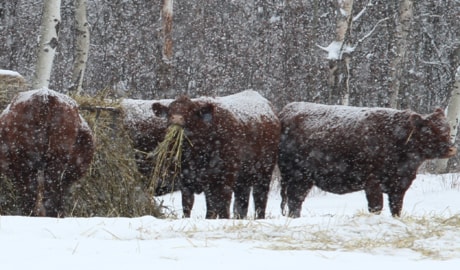Barry Yaremcio has worked in the cattle industry for more than 25 years. But the Stettler-based beef and forage specialist with Alberta Agriculture and Rural Development has had his eyes opened in 2009.
“There are things this year that are absolutely wild, that I haven’t seen before.”
Specifically, this year’s unusual growing conditions — including a late start and subsequent hot, dry weather — have caused energy and protein levels in some forage crops to be lower than normal.
“I’ve seen hay this year that smells good, looks good, has good green colour, but it was just over-mature and they had to supplement a little bit of extra protein, a little bit of extra grain, to balance the ration,” said Yaremcio.
Mineral content has also been affected.
“Some of the rations, the calcium-phosphorous ratios are way out of whack,” he said, cautioning that this could have a significant impact on animal health.
Meanwhile, poor yields in east-Central Alberta and other areas of the province have left producers with inadequate supplies of winter feed. They’re looking at hay costs that are double last year’s prices, said Yaremcio.
Given the current depressed state of the beef industry, many are turning to cheaper alternative feeds, like canola and grain straw, distillers grain and ethanol byproducts.
That also raises concerns that livestock may not get the sustenance they need to maintain their health through the winter.
Particularly during a cold snap like the one experienced last week, malnourished cattle can lose a pound or more a day, said Yaremcio. Come spring, that could translate into reduced performance by breeding cows — including lower pregnancy rates and poor milk production.
In extreme cases, the animals themselves might be in jeopardy.
Doug Sawyer, a cow-calf producer near Pine Lake and vice-chair of the Alberta Beef Producers, said many cattle were already underweight going into winter because of poor fall pasture conditions.
“There are several factors that all came together in this cold snap,” he observed. “This has been building all summer.”
Sawyer and Yaremcio stressed the importance of feed testing, to ensure livestock rations are balanced and sufficient.
There’s nothing wrong with using alternative feeds, said Yaremcio, provided these are supplemented to bring protein, energy and minerals to the proper levels.
Unfortunately, feed-testing and feed cost money that some producers don’t have.
Sawyer said he’s surprised there haven’t already been reports of distressed livestock.
“We’ve certainly got some problems, I’m sure, but they haven’t been jumping out at us.”
That could change as quickly as the weather.
“We could fall off that edge,” said Sawyer. “We’re walking a fine line here.”
Yaremcio urges producers to be vigilant for signs of trouble when checking their cattle and those belonging to others.
“If you see something’s wrong, let’s try to solve the problem before it becomes a real wreck.”
A good first step would be to call the Alberta Farm Animal Care hotline at 1-800-506-2273.
Sawyer, who is chairman of AFAC, said the organization can help troubled producers assess the condition of their animals and work toward solutions. Accessing financing for feed might be possible, or a portion of the herd liquidated to raise money to care for the balance.
“Our mode of operation is to help and prevent the SPCA from coming in,” he said.
Calling Alberta Agriculture’s Ag-Info Centre in Stettler at 310-FARM is another option, said Sawyer, and in extreme cases a call to the SPCA might be in order.
Although cattle are vulnerable, given the state of the beef industry, Yaremcio said other species of animals are also at risk during the winter months. Horses, for example, need a continuous source of water because they may not be able to consume snow from trampled ground.
hrichards@www.reddeeradvocate.com
